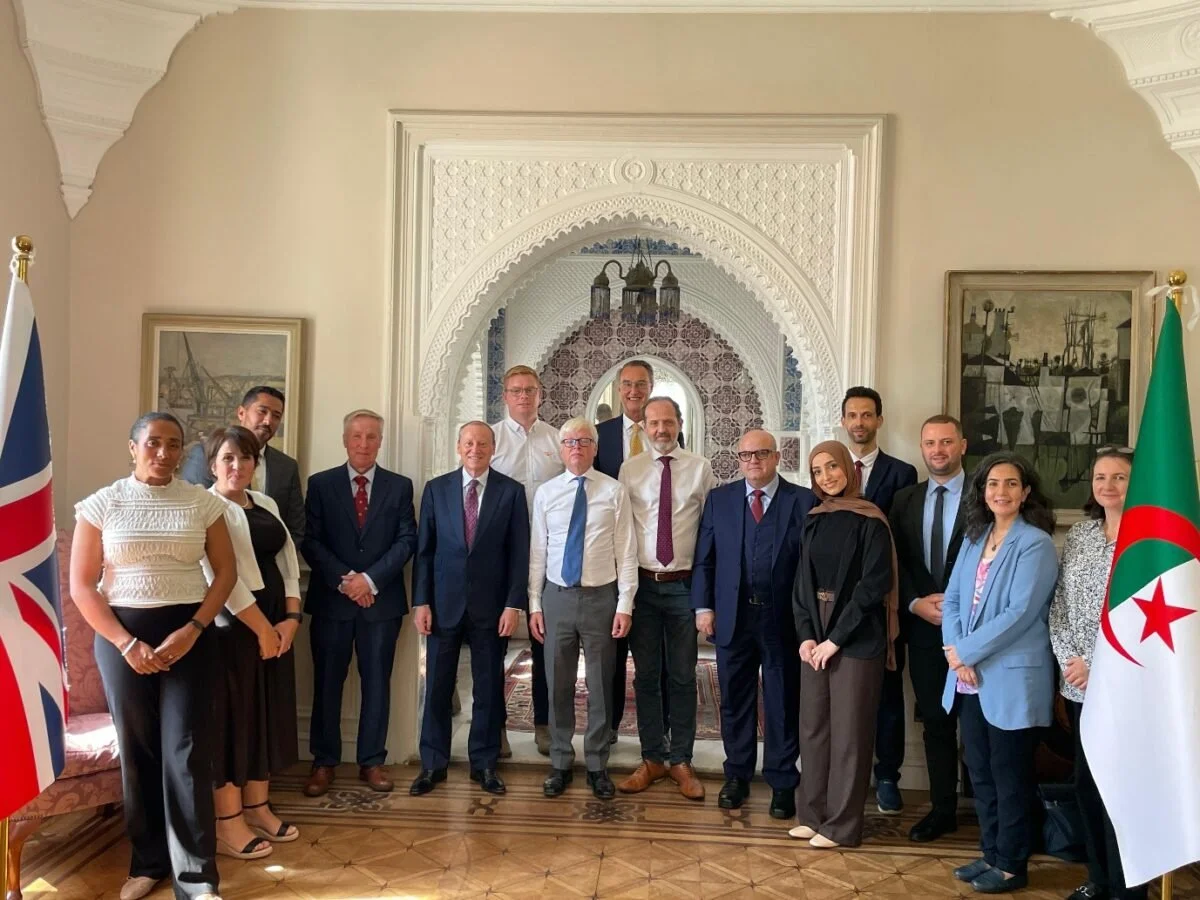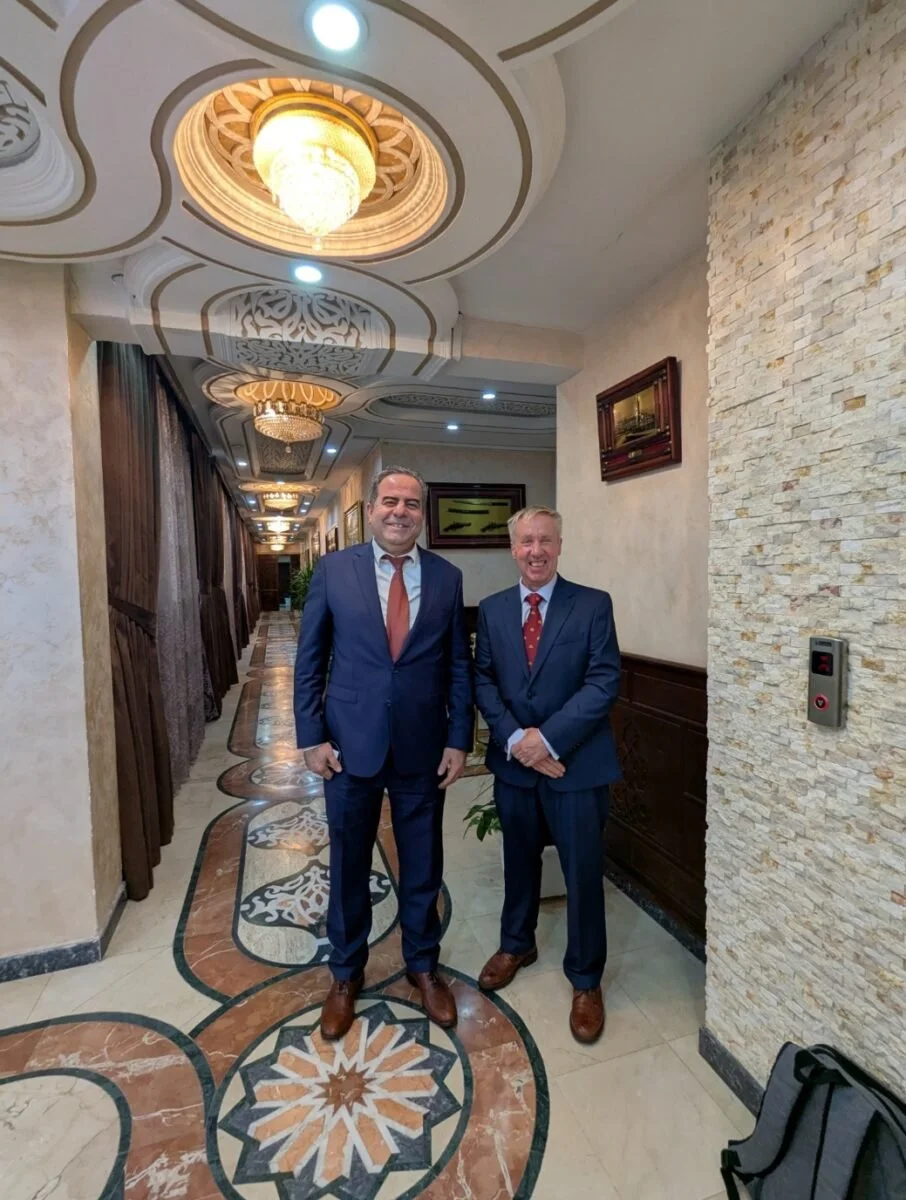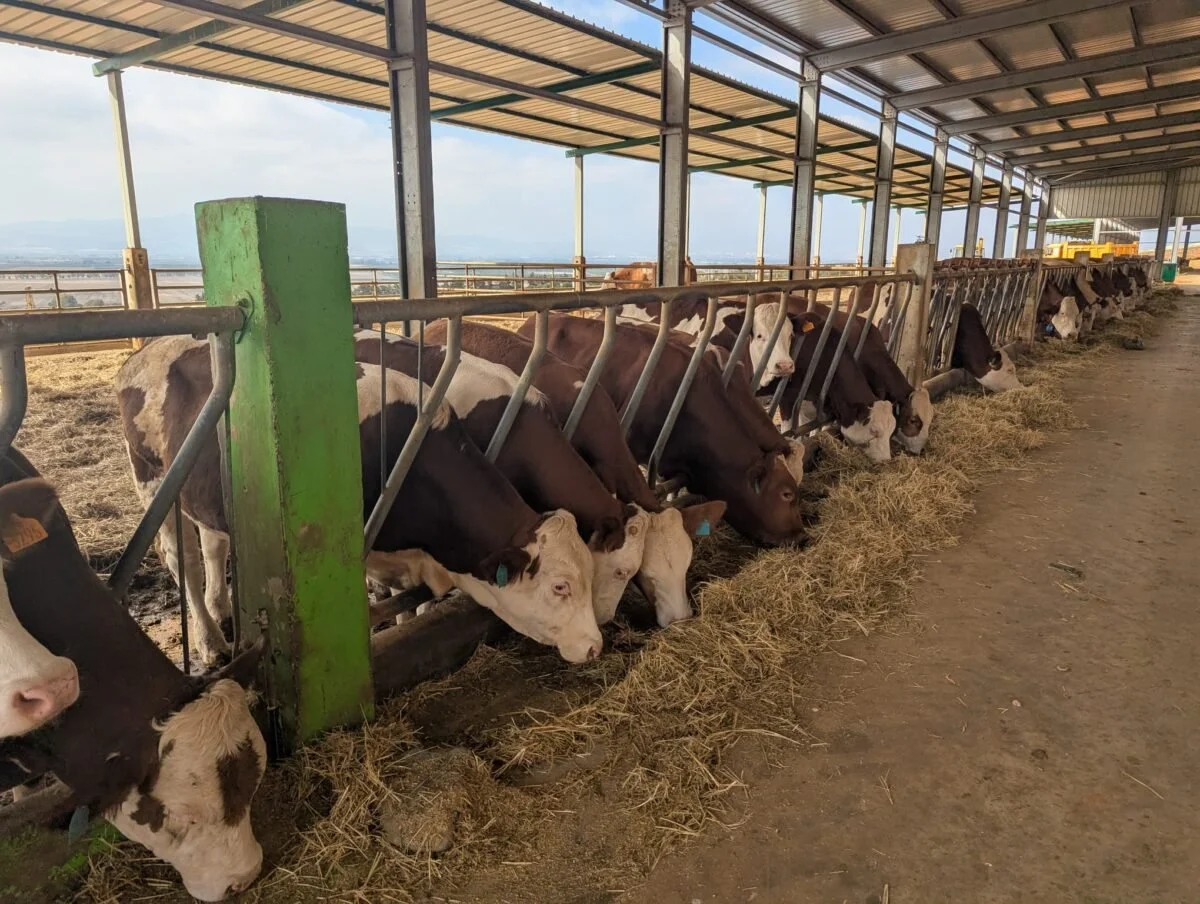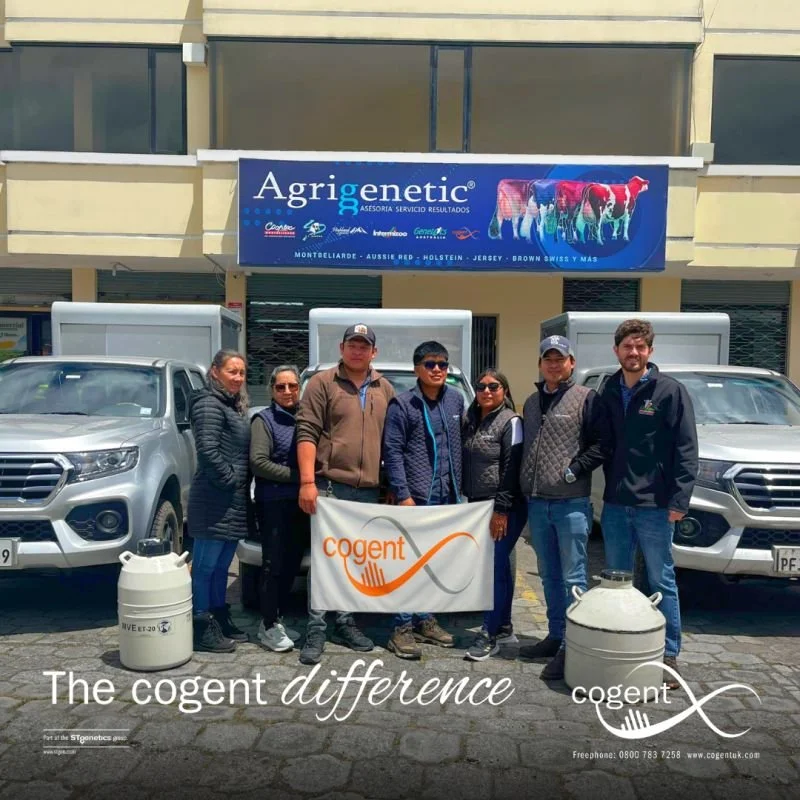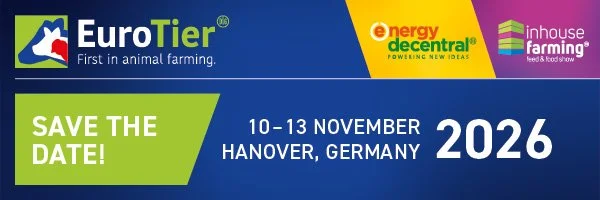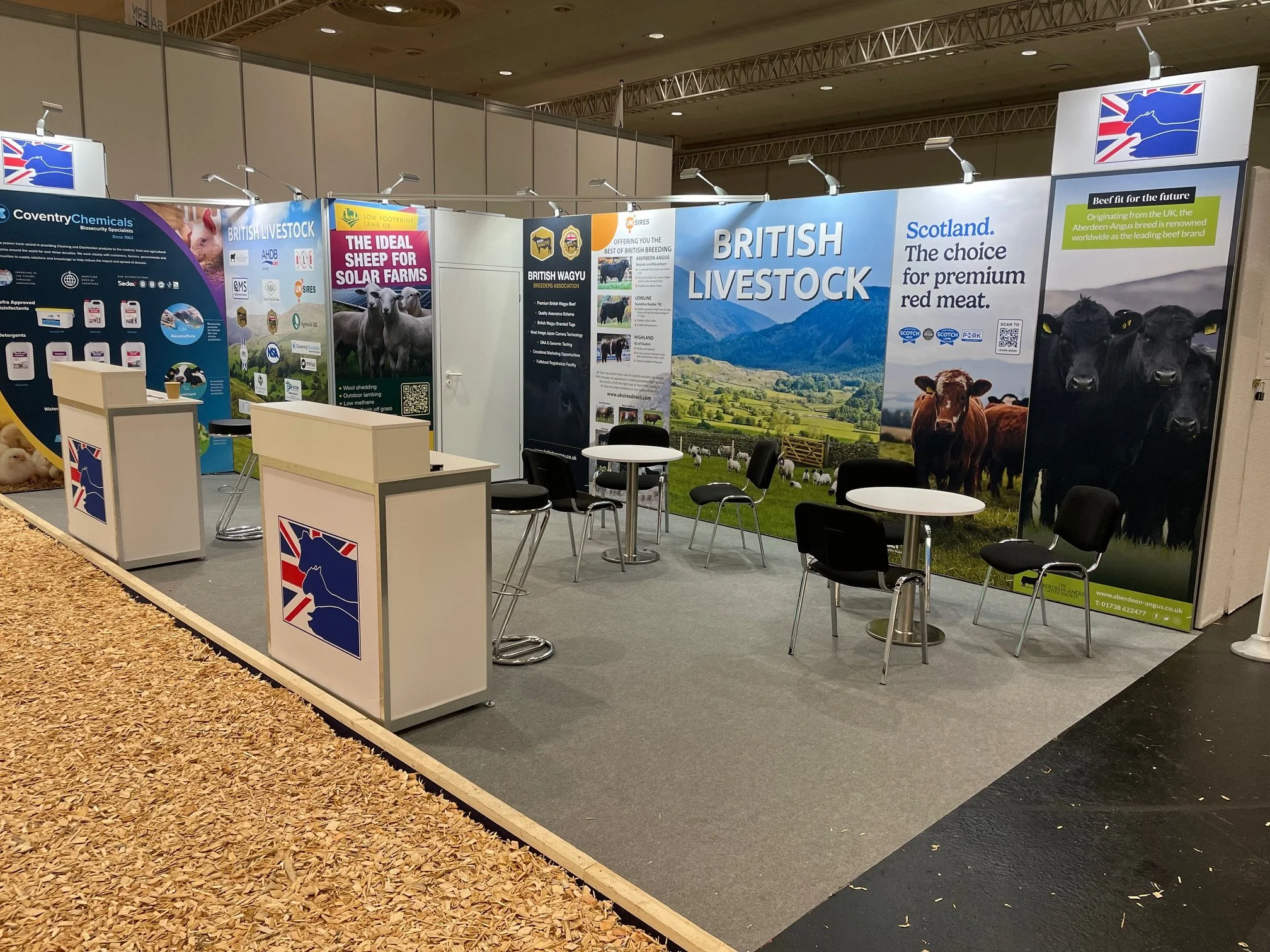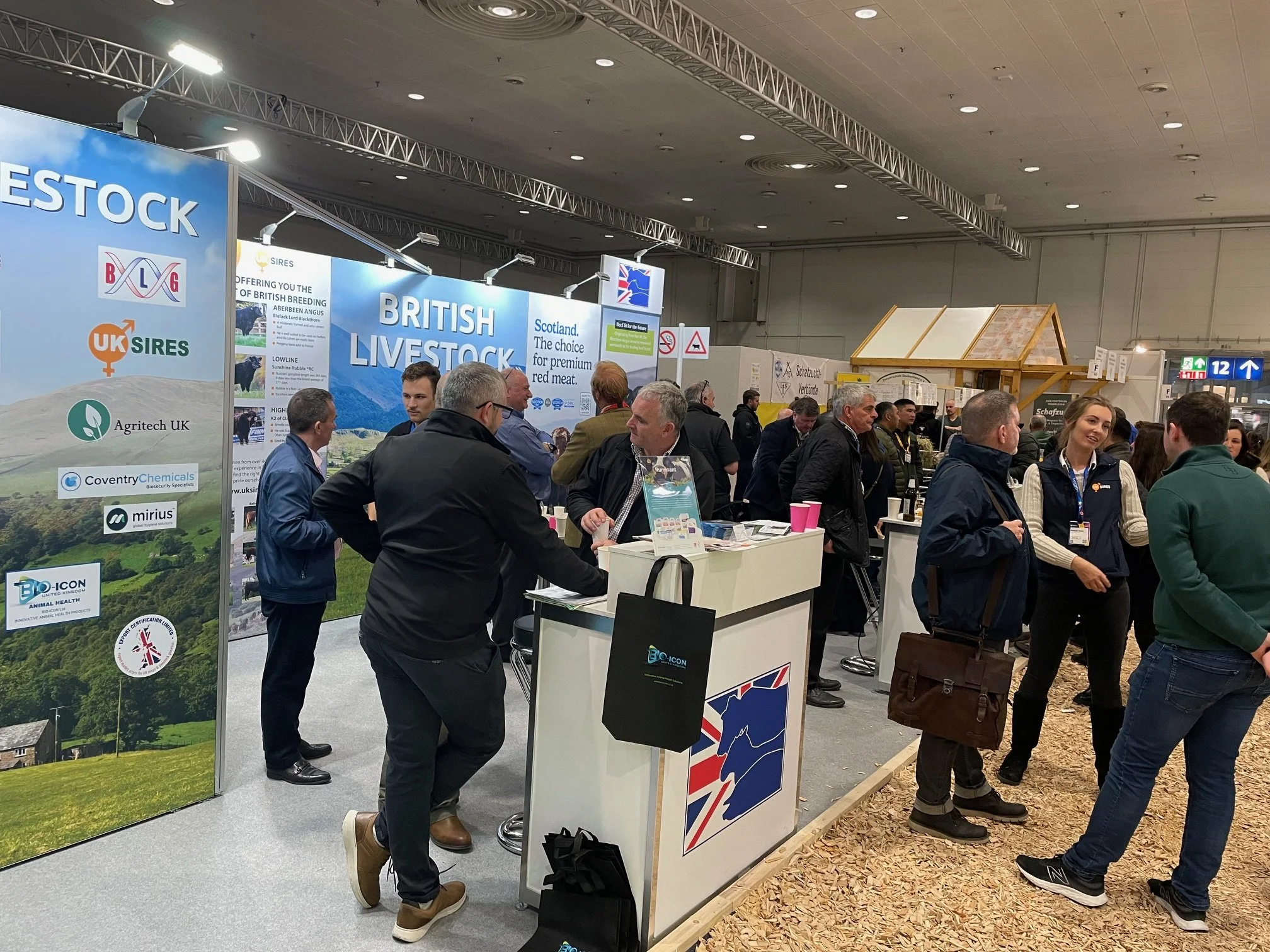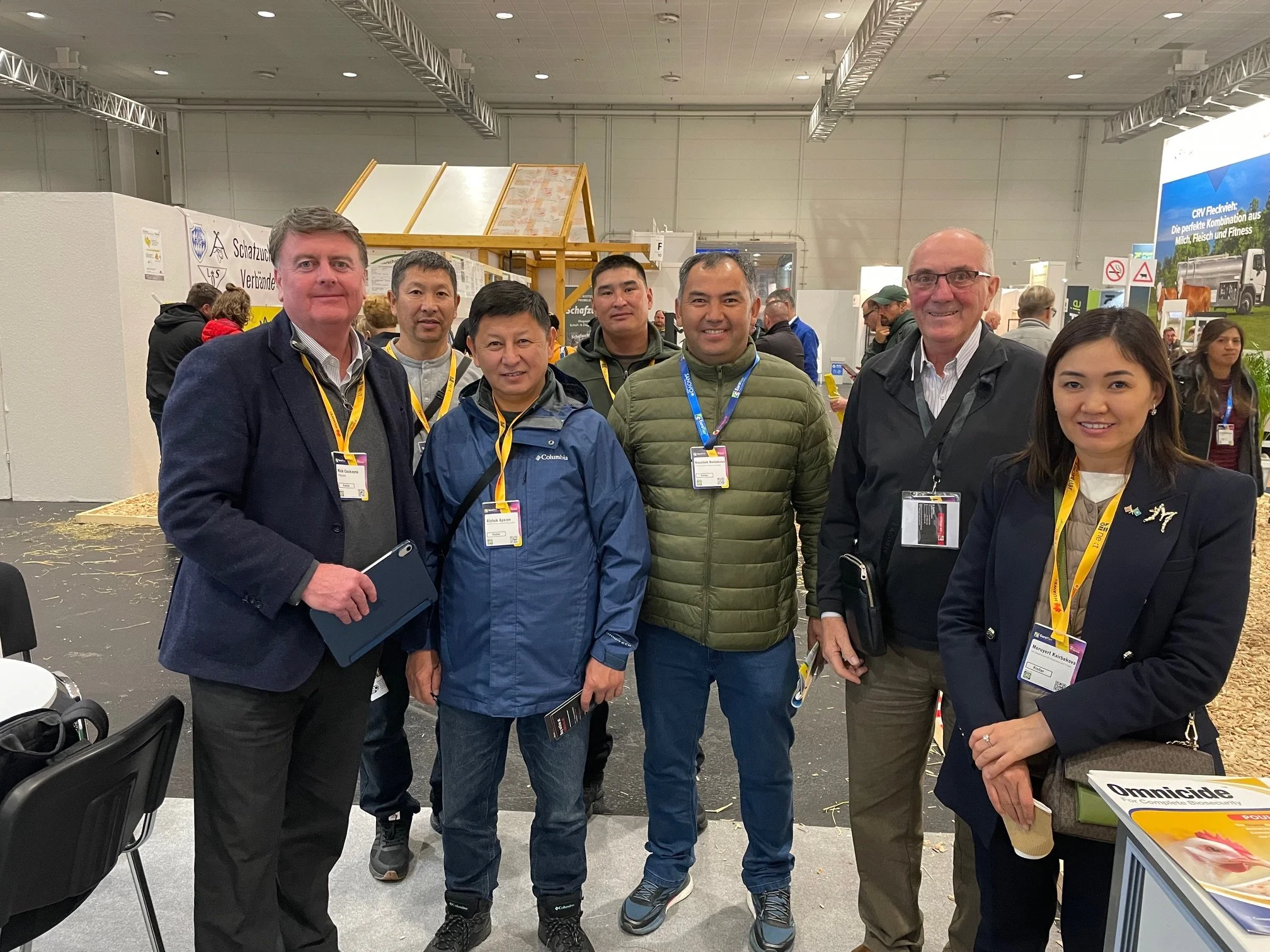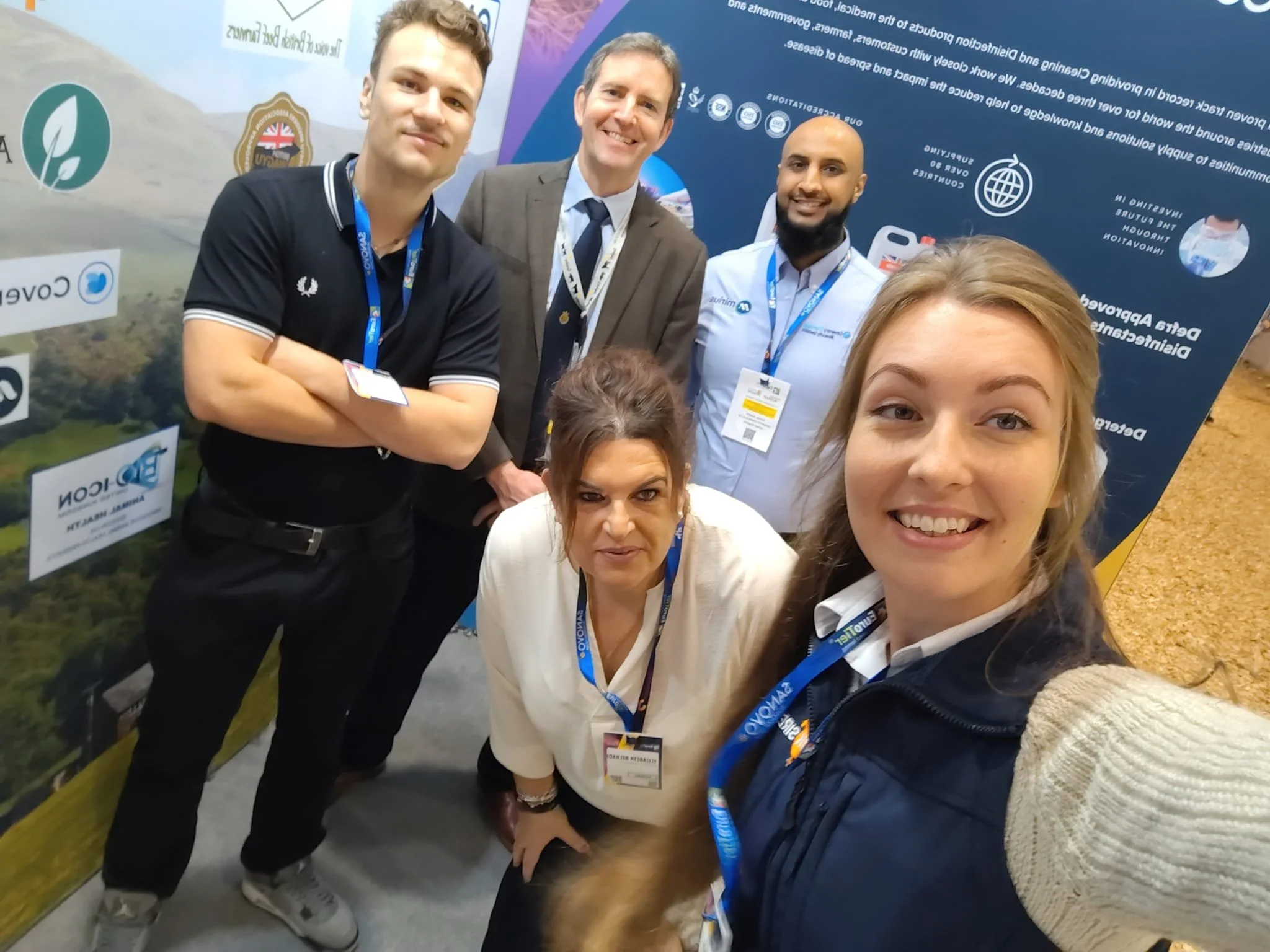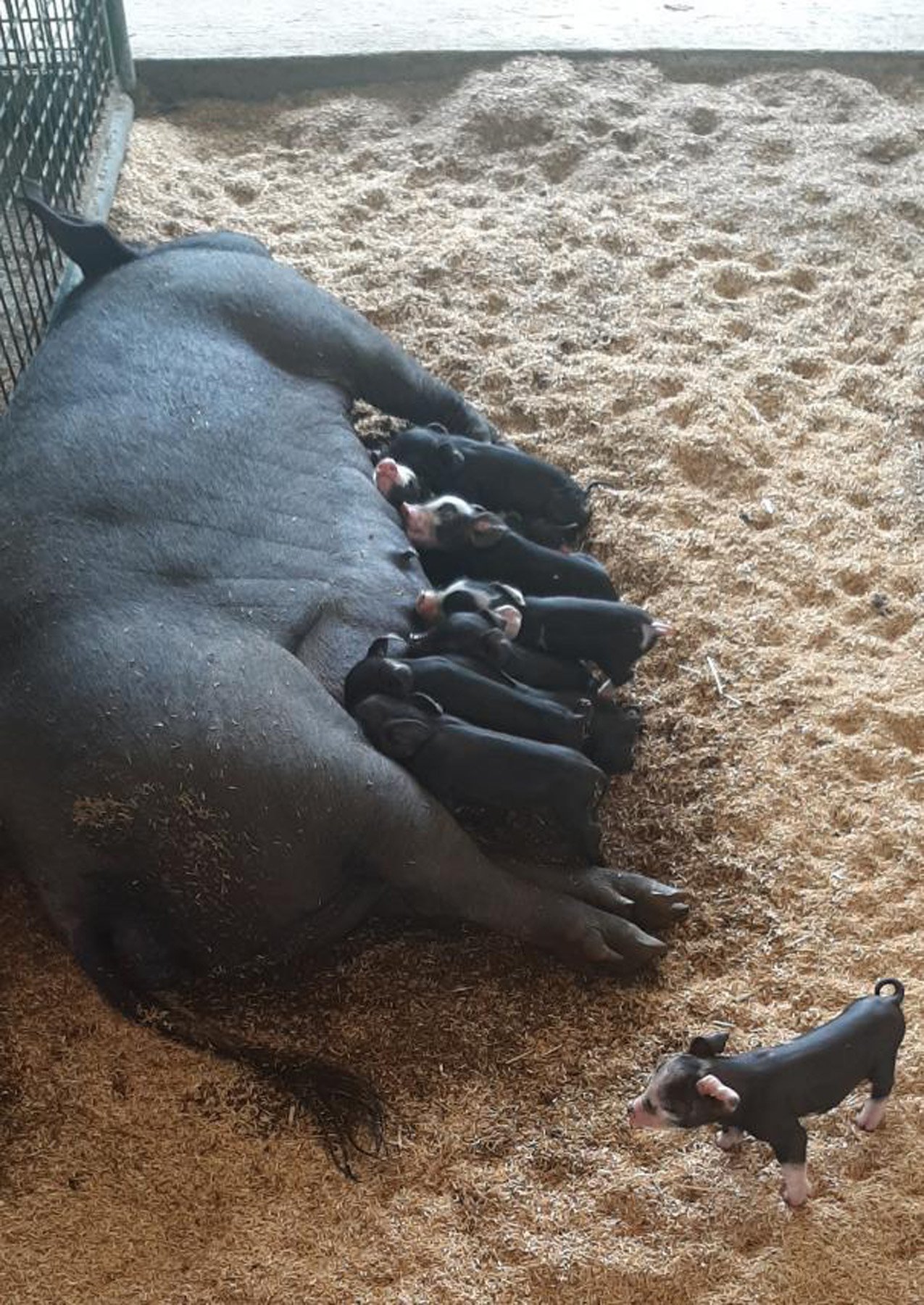Please click HERE to read the latest British Livestock & Genetics Export Bulletin
UK-BRED BULL LEADS YOUNG GENOMIC HOLSTEIN SIRES
UK-born and bred DeNovo Coyote P leads the pack in AHDB’s December genetic evaluations for young genomic Holstein sires, published 2nd December 2025.
Denovo Coyote
This new entry bull, a son of Klassic P, is predicted to transmit an exceptional weight and percentage of fat (62.2 kg and +0.30%) and has a HealthyCow index of £157.
This helps earn Coyote a Profitable Lifetime Index (PLI) of £871 and underlines the role of the UK breeding nucleus within the DeNovo programme, operated by Genus ABS.
He is one of two UK-bred bulls from the programme in the top 10 and five in the top 30.
Climbing into second place is Badger Siemers Day Trip, a Sheepster son with a PLI of £870, thanks to an outstanding daughter Lifespan score of +180 days and superb figures for maintenance (-22) and somatic cell count (-20).
In third place, Progenesis Preston, also by Sheepster, moves up with a PLI of £867, offering impressive protein transmission at 41.7 kg.
Up one position since August to fourth place is DeNovo 20723 Columbia, a high-ranking son of Leeds with a PLI of £864, excelling in milk yield at 1,140 kg and boasting a tremendous Feed Advantage (FAdv) of 240 kg.
This means Columbia daughters are expected to consume 240 kg less dry matter in each lactation than daughters of a bull transmitting comparable milk production, which has a FAdv of zero.
Adaway Beyond Fitness ranks fifth (PLI £862) and lives up to his name with a high daughter Fertility Index of +10 and a HealthyCow of £205.
Joint sixth with a PLI of £860 are Peak AltaValuepack and Adaway Beyond Faithful, the latter being a herd-mate and maternal half-brother to the fifth-ranked bull. Both score strongly for HealthyCow traits.
See the full list of available Holstein genomic young sires
The bulls ranked eighth and ninth are new entrants, DeNovo Charisma at PLI £856, also being a maternal half-brother to the number one bull, Coyote. Charisma transmits high milk (1,122 kg) combined with exceptional udder health (SCC -27, Mastitis -2) and a HealthyCow of £221.
The other newcomer, Hendel Manson (PLI £853) is predicted to perform well for Lameness Advantage (3.1) and Feed Advantage (214 kg).
Rounding off the top 10 is DeNovo 20893 Harmony, with the best Feed Advantage among the top 20 bulls at 291 kg, a PLI of £845 and the highest environmental credentials of the breed, with an EnviroCow of 4.8.
Other new bulls making the top 20 include DeNovo Mascot (PLI £833), a maternal half-brother to Harmony, showing excellent udder health and the best daughter fertility in the top 20 at FI 12.9.
Finally, two paternal half-brothers by Dominance join the list: Genosource Youdontsay (PLI £827) with high solids production (92.9 kg fat plus protein), and Progenesis Persimmon (PLI £826).
Marco Winters, head of animal genetics, AHDB, said:
“All top bulls in this young sire ranking are predicted to transmit improved feed maintenance thanks to smaller body sizes – a highly desirable trait that reduces feed costs and contributes to a lower carbon footprint.”
GLOBAL SHEEP PRODUCERS MERGE WITH INTERNATIONAL MEET SECRETARIAT
Global Sheep Producers Forum Merges with International Meat Secretariat
Global partnership strengthens voice of sheep producers worldwide
The Global Sheep Forum (GSF) and International Meat Secretariat (IMS) will work together for a one-year trial period to collaborate on shared challenges and opportunities across the global sheep industry.
Announced as part of the World Meat Congress in Brazil in November, the alignment will benefit the global sheep industry by strengthening collaboration, improving knowledge exchange, and aligning strategic priorities for the international sheep farming community.
As part of this agreement, members of the GSF, including Sheep Producers Australia, Agricultural Horticulture Development Board, American Lamb Board, Beef + Lamb New Zealand, Canadian Sheep Federation, National Sheep Association and National Wool Growers Association of South Africa, and IMS will meet virtually during the coming year to discuss issues of importance to the global sheep industry.
IMS will provide secretariat support for the merged group, including meeting coordination, documentation, and communications.
A review will be conducted at the end of the trial to assess the effectiveness and value of the merger with feedback collected from members and stakeholders. This will determine if the partnership continues and will suggest improvements.
Beef + Lamb NZ Principal Policy Advisor Nicholas Jolly will chair the group for this initial year.
Nick grew up on a high-country sheep farm in the South Island of New Zealand and has been involved with the Global Sheep Forum for the last five years.
“Beef + Lamb NZ is a longstanding member of both the GSF and the IMS and looks forward to the opportunity to bring the groups together, given their shared focus on all aspects of sheepmeat production,” he said. “We have always felt that we are stronger as a global industry when we work together and there are many opportunities for collaboration.”
IMS Secretary General Phil Hadley agreed.
“The Global Sheep Forum and the IMS Sheep Committee have shared goals and bringing them together enhances opportunities for discussion on a range of key issues for the sheepmeat industry,” he said. “I’m looking forward to bringing the two groups together.”
Source: GSPF/IMS
KENYA OPENS TO UK GENETICS
Farming Online reports, 11 Nov 2025, www.farming.co.uk
Agri-food attachés secure new export opportunity in Kenyan market for British sheep and goat genetics worth around £700,000 a year
Kenya's predicted rise in sheep and goat numbers creates sustained demand for genetics, bringing economic opportunity to UK livestock sector and delivering on government's Plan for Change
Agreement builds on UK's global reputation with genetics stock exported to more than 100 countries
UK sheep and goat breeders have gained access to Kenya's estimated 46 million-strong livestock market after the UK government struck a deal on exporting genetic material.
The agreement - worth around £700,000 a year according to industry estimates - will help address Kenya's growing demand for high-quality breeding stock as the country works to improve food sufficiency for its rapidly expanding population.
Kenya's sheep and goat numbers are predicted to rise significantly in coming years, creating sustained demand for the UK's world-leading livestock genetics.
From Angus beef and Large White pigs to Suffolk sheep and Dorking chickens, the UK has long been a centre for genetics research, with its pioneering technologies and methods making its genetics highly sought after globally for their diversity, resilience, and quality.
Industry estimates that UK breeding stock forms the basis for over 70% of the world's poultry, while UK bovine genetics are being exported to every continent, enabling access to more than 100 countries worldwide.
Minister for Food Security Dame Angela Eagle said:
"UK livestock genetics have earned a global reputation for excellence, with countries around the world seeking out our breeding stock to strengthen their agricultural sectors and improve food security.
"It was a pleasure to meet with our agri-attachés last week and hear first-hand about the excellent work they are doing to champion UK agriculture across the globe.
"This new opportunity with Kenya demonstrates the global demand for the high quality that defines UK agriculture. This is exactly the kind of international collaboration that strengthens both our agricultural sector and our trading relationships worldwide as part of our Plan for Change."
The agreement builds on demand for a range of UK genetics. UK rams derived from imported embryos are selling for record prices in Argentina, while UK pig breeders have pioneered the use of frozen semen to export high-quality genetics to countries affected by African Swine Fever, significantly reducing the disease risks associated with transporting live animals. Earlier this year, Turkmenistan opened up its market to the UK for high-value poultry genetics, worth a quarter of a million pounds a year.
These latest trade agreements demonstrate a significant economic opportunity for the UK’s premium poultry and livestock to meet growing global demand for quality breeding stock, expanding international trade as part of the government's Plan for Change.
Marcus Bates, Industry Chair UK Export Certification Partnership said:
“The network that we have built up through partnership working is now delivering great results for UK livestock genetics exporters. Industry funding from companies and levy boards is matched with the support of the Market Access and Veterinary Trade Facilitation teams and now with the support of the Agri-Attaches worldwide, we are able to compete with the USA and some EU countries who have been using Ag Attaches for many years.”
Richard Griffiths, Chief Executive, British Poultry Council
“70% of the world’s poultry is rooted in high-value UK breeding stock, an export industry estimate is worth £320 million. Combined with full traceability, renowned standards, and strong trade opportunities, British poultry genetics are key to global food security.
“Our trade attachés play a vital role in that success, championing British poultry meat worldwide. Since 2024, they have kept food trade moving during periods of avian influenza, secured various regionalisation agreements, and have opened Turkmenistan for high-value genetics worth a quarter of a million pounds - ensuring British poultry continues to reach people around the world. We look forward to continuing our close work together."
The agreement is credit to Defra's agri-attachés and follows a recent industry engagement week, where the agri-attaché network met with producers whose interests they represent overseas.
These industry meetings help attachés understand the experiences of UK exporters and identify new opportunities in their respective territories, enabling the UK to compete in important global markets.
The above is reproduced from Farming Online, 11 Nov 2025, www.farming.co.uk
MISSION TO ALGERIA
OUTWARD MISSION TO ALGERIA
UK Agritech Firms Explore Opportunities in Algeria on Landmark Trade Mission
16-19 September 2025 saw a delegation of UK agritech companies take part in a pioneering trade mission to Algeria, signalling fresh opportunities for collaboration between the two nations in agriculture and food security.
The visit, organised by the Algeria British Business Council (ABBC), marked the first such mission of its kind. It brought together six UK companies specialising in agricultural technology, including UKTAG, Lacuna Space (satellite connectivity for agriculture), Date Palm Development (tissue-cultured plants), Anpario (natural feed additives), Cogent (genetics and bull semen export), and Airponix (hydroponic seed potato systems).
The delegation was welcomed on its opening day at the British Ambassador’s residence in Algiers. The mission benefited from the expertise of former Ambassador to Algeria and Chairman of ABBC, Mr M. Roper OBE, and the support of the current Ambassador, HE James Downer.
Key engagements included business-to-business meetings with members of the Algeria Business Council and a high-level session with the Secretary General of the Ministry of Agriculture and senior officials. Algerian authorities outlined their ambition to expand the country’s agricultural sector from subsistence farming into a more industrialised and productive system.
The visit also highlighted major private-sector investment. Mr Maurice Ghattas of Baladna hosted the delegation and shared plans for a vast 270,000-head dairy project in central Algeria, backed by Qatari partners. The initiative is expected to employ 5,000 people and deliver more than 400 calvings per day once fully operational.
Field visits gave delegates a first-hand view of Algeria’s diverse farming landscape—from a hillside dairy producing cheese and yoghurt for the Algiers market to large-scale agricultural ventures in the Sahara. In regions once thought inhospitable, underground water resources are enabling the cultivation of dates, maize, and even livestock farming.
One of the mission’s most memorable encounters was with 94-year-old farmer Hadjadj Mahmoud, whose operation supplies the only fresh dairy to his entire town and surrounding areas. His resilience and innovation impressed both UK and Algerian participants.
For UKTAG and its partners, the mission underscored Algeria’s potential and the role British expertise could play in boosting productivity, particularly through animal health programmes, genetics, and improved feed systems. Algeria currently imports over one million sheep annually for festivals, as well as large volumes of milk powder to meet domestic demand.
“Knowledge sharing, veterinary support, and UK genetics could help transform Algerian farming,” Rob Grinnall (UKTAG) said. “While access to the market may present challenges, this mission has shown that opportunities are real and achievable.”
According to the ABBC, at least two of the companies involved are already advancing towards concrete agreements following the visit—an encouraging sign for the future of UK-Algeria agricultural trade.
COGENT ANNOUNCES BREEDING 'FIRST' IN ECUADOR
Agrigenetic Ecuador pictured with the first semen tanks from Cogent with UK genetics
Cogent Breeding Ltd has announced their very first export of UK-sourced genetics to Ecuador, a milestone that has been years in the making.
Says Cogent: “This achievement reflects the power of collaboration, with support from DBT and DEFRA, in navigating the export health certification process. The commitment of our distributor Agrigenetic Ecuador, who shares our passion for bringing genetic progress to producers around the world. And the dedication of our global Cogent team in ensuring access to The Cogent Difference wherever our customers are.”
“At Agrigenetic, we are proud to announce that we have finally completed our first import from the UK, bringing in top genetics from Cogent. After years of effort and collaboration, this milestone offers Ecuadorian producers a powerful and different genetic alternative. Our customers are excited to access this new portfolio, which is already making an impact on the field,” says Luis Miguel Gallegos of Agrigenetic SA.
UK REMAINS THE GLOBAL LEADER IN THE UPTAKE OF SEXED DAIRY SEMEN
UK REMAINS THE GLOBAL LEADER IN THE UPTAKE OF SEXED DAIRY SEMEN
Courtsey of AHDB News Release Thursday, 4 September 2025
The UK has once again confirmed its position as the global leader in the use of sexed dairy semen, with uptake now reaching 84% across all dairy breeds.
The latest survey of breeding companies shows sustained progress, with Holsteins continuing to show the highest uptake at 89% of semen used being sex sorted. AHDB data collected from April 2024 to March 2025 also shows a 1% increase in the use of beef semen compared to the previous year, now standing at 53%.
British Blue (42%) and Aberdeen Angus (38%) are still the most popular breeds used by dairy farmers. These trends present excellent opportunities for dairy farmers to selectively breed their most elite females for dairy replacements, helping to accelerate genetic progress within the national herd.
Tools such as our genomic evaluations and Herd Genetic Report allow farmers to easily identify their highest-performing females to breed from.
Dairy farmers now benefit from improved access to genetic information, enhanced mobile compatibility and a suite of new tools to support better-informed breeding decisions, all available on our new dairy genetics website.
The shift towards sexed and beef semen use is also having a direct impact on the beef supply chain, with a growing proportion of dairy-origin beef crosses entering the market.
These animals also benefit from improved dairy genetics, which are contributing to greater efficiency and environmental performance in their offspring.
Marco Winters, AHDB Head of Animal Genetics, said:
AHDB’s Marco Winters
“This continued growth in the use of sexed and beef semen reflects a shift among UK dairy farmers.
“By making more strategic breeding decisions, farmers are not only improving the genetics of their own herds but also contributing to a more efficient and sustainable supply chain across both dairy and beef sectors.”
EUROTIER 2026 - EXPRESSIONS OF INTEREST BY 30 OCTOBER
The British Livestock sector has benefited from a strong presence at EuroTier events held over many years with a dynamic joint industry stand supported by cattle, sheep and pig societies alongside breeding (AI & ET) and other associated companies.
We are planning a ‘British Livestock Pavilion’ at EuroTier being held in Hannover, Germany, Tuesday 10th – Friday 13th November 2026 but this will only happen with industry support. Packages are available at either £1,250 or £3,000. You will find full details of each package below.
Held every two years, this is the world’s largest indoor livestock exhibition boasting 150,000+ visitors and over 2,300 exhibitors – half of whom are international companies. As such, a strong UK presence at EuroTier allows British farming and breeding organisations to promote themselves on the global stage.
British Pavilion at EutoTier in 2024
The proposed joint 8x4m British Livestock Pavilion will be as usual in Hall 11 (the main animal breeding/genetics area) to provide a platform for promoting our sector under one roof.
Participating companies at £1,250 will benefit from their own individual ‘pod’ (see image below) including a small graphic panel (1m x 1m approx), company information/logo in the British Livestock brochure, joint display panel graphic with logo, and interpreter.
Those at £3,000 will benefit from their own dedicated double display panel (2m x 2m approx) on the side or back walling of our corner stand (see image below), company information/logo in the British Livestock brochure, joint display panel graphic with logo, interpreter, an entry ticket plus an advert in the British Livestock brochure.
Proposed design of 2026 British Pavilion at EuroTier showing ‘pod’ layout, and double display panels on back walling
Stand Manager will be Richard Saunders on behalf of British Livestock Genetics (BLG) Consortium & UK Export Certification Partnership (UKECP).
EuroTier 2024
Kazakh delegation at 2024 event
We would be grateful to receive any further expressions of interest by 30th October 2025 as bookings close in November.
If you would like any further information regarding participation, please contact Richard Saunders on 07901768904 or richardsaunders1965@yahoo.co.uk.
SUMMER EXPORT BULLETIN OUT NOW!
Please click HERE to read the latest Summer 2025 Livestock & Genetics Export Bulletin. Wishing you a good read :)). If you have any export-related livestock or genetics news to share for this website or perhaps for the next edition (Winter 2025) please get in touch with Richard E: richardsaunders1965@yahoo.co.uk. Thank you.
JAMAICA AGRI-INVESTMENT FORUM 17-19 SEPTEMBER
Agri-Investment Forum & Expo Jamaica
Agri-Investment Forum & Expo, 17-19 September 2025 in Jamaica. This high-level event presents a strong platform to showcase innovative agri-solutions and build strategic partnerships across the region.
🔗 Event Details: https://www.agribizjamaica.com/agri-business/
We’re particularly keen to connect companies involved in the following subsectors:
Crop Nutrition
Livestock & Poultry
Aquaculture
Agro-processing
Agritech & Digital Tools
Agricultural Equipment
Agricultural Finance & Insurance
DBT has secured approval for a dedicated UK Pavilion, with DBT covering the booth and space rental. While the core exhibition space is covered, we kindly ask that companies factor in any minor individual costs (e.g. stand graphics or customised branding) into their own budgets. DBT will cover the cost of the main booth and exhibition space. However, space within the Pavilion will be allocated on a first-come, first-served basis and organised by subsector. If demand exceeds the initial capacity, we may look to rent additional booth space. In that case, participating companies may be asked to contribute to the cost of the additional stand, which would be shared proportionally.
If any of your members are interested in joining us, I’d be grateful if they could confirm by 30 July, so we can begin making the necessary arrangements.
Please don’t hesitate to reach out if you have any questions. Chris Jackson exports@uktag.co.uk
INTERNATIONAL FLAIR TO ROYAL THREE COUNTIES
INTERNATIONAL FLAIR TO ROYAL THREE COUNTIES
UKTAG, working with the Royal Three Counties Show, used this year’s event to invite international delegates and London-based Ambassadors in order to demonstrate the breadth and excellence of UK Agri Tech and livestock genetics.
With a lot of machinery covering agriculture and forestry on show and the largest number of livestock of all breeds present, the visitors agreed that the chance to visit gave them an excellent insight in to the UK’s capabilities.
On Thursday 12th June, UKTAG hosted a networking event for delegates from Mongolia, Azerbaijan and Argentina. Organised by UKTAG’s Chris Jackson and funded by DBT Central Asia and LATAM, it brought together international visitors from companies covering genetics, breed societies, chemicals, equipment and IT.
Hampshire Down Championship Presentation
On the Friday, the Royal Three Counties Society hosted the guests at the show. Visitors from Argentina, all members of the Argentinian Hampshire Sheep Breeders Association, continued to build on the already strong relationship that has been developed with the UK Association and supported by Federico Perez Wodtke working for the British Embassy in the Argentine along with UKTAG’s Director Rob Grinnall. This meeting also saw a launch of the campaign for the First World Hampshire Congress which will take place at Palermo Show in Buenos Aires in July 2026. The guests presented a sash for the Champion Hampshire bred this year by Stephen Short, whose ram lamb was champion out of the 120 entries at this National Show whilst reserve was Adrian Rundle’s ewe lamb.
After the classes, This was followed by a drinks reception hosted by the Hampshire Down Sheep Breeders Association. Charles Hurst, President of the Society, received the President’s Trophy given by the Argentinian Association for its inaugural presentation.
His Excellency the Ambassador for Mongolia and his wife were called forward for photographs with the Champion Beef Cow
Saturday saw the Royal Three Counties and UKTAG arrange for dignitaries to visit from London and they had the honour of welcoming HE the Ambassador of Mongolia to the UK, Mr Battumur Enkhsukh, the Counsellor in charge of economic and trade affairs, Mr Zorigtbat Tseveenjav, and the First Secretary of the Embassy of Tajikistan, Mr Zafar Safarov who all contributed to important discussions about trade and innovation. These guests were given tours and met with the Young Farmers and NFU before sitting with the Show Vice Presidents, CEO and Society Chairman and guests for lunch. Our visitors were hugely impressed and wish to expand and continue this collaboration with the UK.
Pictured with the Ridden Hunter Champion
On Saturday evening, the Argentinian visitors were given a forum space to promote their World Congress in 2026. Dr Rob Grinnall spoke first welcoming the 50+ audience thanking the visitors, the Association and President Mr Charles Hurst, going on to explain the work of UKTAG in facilitating exports of genetics, not just to Argentina, but worldwide. Rob explained the challenges, but also the rewards of selling genetics and building relationships with those sharing a passion for the same breed.
Hampshire Down International Forum
Finally, Federico Wodtke explained his role in the whole of South America and how he is supporting visits to and from the region through local embassies. His work and experience in these missions has played a huge part in developing these relationships.
This proved a hugely successful visit and a first step by The Royal Three Counties towards becoming a recognised international venue for agriculture. E: chris@uktag.co.uk
BRITISH PRESENCE AT MARYLAND SHEEP FESTIVAL
Maryland Sheep and Wool Festival 2025, USA 3-4 May 2025
UKTAG was delighted to be invited to the Maryland Sheep & Wool Event held 3-4 May to represent the UK sheep industry and the breeds we have to offer the US market. The popular show attracts around 20,000 visitors over the two days, has around 650 sheep present and over 250 wool and/or-sheep-related stands.
Supported by AHDB, the DBT British Embassy Washington, Farmgene, AB Europe, UK Sheep Genetics and Ballycreely Livestock along with the Bleu du Maine Sheep Society, the Blue Faced Leicester Sheep Breeders Association, the Hampshire Down Sheep Breeders Association and the Suffolk Sheep Society, Rob & Vicky Grinnall manned a stand at the event for the two days.
The British stand at the event
The interest was constant. Probably the most significant factor in this was that UKTAG was the only organisation with an international stand. We were given a prime position between the pens and the showrings which were occupied constantly for the two days of the event. No other breed, organisation or country had taken this initiative and so the breeders and public alike were fascinated with all that we had on display and wanted to discuss sheep with us. Supreme Champion Ram was a Lincoln Longwool and the Supreme Champion Ewe was a Black Border Leicester. On display was the first Dutch Spotted to attend the event born from a UK embryo and his pen mate was a superb example of a Shetland Ram.
Conversations varied from the easy ‘what breed is that’ to the technical discussions on scrapie and schmallenberg and how we could work with the US to progress the imports. Another significant part was putting to rights those apocryphal tales where issues had been interpreted as being of UK origin, when in fact it was a US stipulation. Says Rob: “This sort of interaction is only possible face to face and undoubtedly was of tremendous help to some in understanding the process.”
At the British Embassy, Washington DC
As part of the arrangement with the Maryland Sheep & Wool Co (MSW), Rob spoke for an hour to a packed and interested audience on the export process, how it developed, the issues and how to overcome any pitfalls, with questions lasting for another half hour after the allotted time.
John Wilkes, the US consultant for AHDB and a journalist, also played a large part in ensuring that Rob was in front of the right people. These ranged from representatives of the MSW committee, the ASI, NSIP, as well as breeders who had already imported and those who were considering the process.
On Monday 5th, Rob and Vicky were hosted at the British Embassy in DC by UK Agriculture Attache to the USA Will Surman to discuss the event, the outcomes and future actions. Will’s support for UK agri-trade and his understanding of the sector are a huge benefit and critical to how this is all progressed after this initial foray into the sheep industry in the US.
Understanding markets is crucial to the export sales and each is different; the USA is unique. Many of the breeds are already present, but their gene pool has been closed for decades to purebred animals. In addition, the largest market at present is that of the ‘hobbyist’ with spendable cash, looking for something different and exotic. Huge amounts have been spent on the Swiss Valais and new breeds entering the US are the Kerry, Dutch Spotted, and BDM. Blue Faced Leicesters, Border Leicesters and many of our traditional breeds are present but no longer resemble the original imports and it is here that much work could be done.
The US meat market is also changing. Their large-framed sheep are losing some appeal and the UK smaller carcases find a space in the housewives’ baskets, with family cuts, low on fat and bone. The sheep that we are exporting will not take-over the USA meat market to any real significant effect, but when some breeds in the UK find themselves short of new breeders, exports can be a significant extra income to the pedigree flockmaster.
“We need to continue to showcase our amazing variety of breeds to the US and the world. Improving sustainability and productivity is great for farming around the world, but it also acts as an extra income stream here in the UK,” adds Rob. It is now important that the contacts created are followed up to ensure best uptake and maintenance of the work done. As such, Rob will be contacting relevant UK businesses to ensure business is created.
With thanks to The Maryland Sheep and Wool Committee for allowing us to attend this influential event. This visit would not have been possible without the support from Will Surman, the British Embassy, the semen collection centres, breed societies and of course the MSW Committee.
Dr Rob Grinnall, Veterinary Director, UKTAG (UK Technology for Agriculture & Genetics) E: rob@uktag.co.uk
LIVESTOCK & GENETICS EXPORT STRATEGY 2025/2026
Livestock and Genetics Export Strategy 2025/2026
INTRODUCTION
In 2018, we introduced the first integrated Livestock and Genetics export promotion strategy bringing together the resources of the Agriculture & Horticulture Development Board (AHDB), the Department of Business & Trade (DBT) through British Embassies abroad and the UK Export Certification Partnership (UKECP) in a co-ordinated programme managed by industry stakeholders British Livestock Genetics (BLG) and UK Technology for Agriculture and Genetics (UKTAG).
Delegation from Latin America
Having built momentum through the Brexit transition period, the strategy is designed to take advantage of the prediction that 90% of growth will be outside the EU and enable the UK livestock sector to exploit the increasing demand for meat and milk in these developing markets.
Stand at CAHE, China
Our two high level objectives are to maintain and expand existing market share and develop new market opportunities. These objectives are to be achieved through a programme of inward and outward missions working with DBT as well as the eleven Agricultural Attachés based in British embassies and consulates around the world - in Canada, Mexico, USA, Brazil, Kenya, The Gulf, India, Japan, China, Thailand and Vietnam - working to remove trade barriers, identify emerging international markets and tap into growing demand worldwide for quality goods from UK farmers and producers.
UK-bred sheep out in Uruguay
PROVISIONAL PROGRAMME 2025-26
USA/USA Sheep Event/Spring/Sheep
Argentina/Palermo Show/Summer/Cattle & Sheep
Brazil/ExpoInter/Summer/Cattle & Sheep
UK/Central Asia Inward Mission/Spring-Summer/Cattle
Asia/Central Asia/Outward Mission/Summer/Cattle
Asia/Smart Agri Week/Autumn/Pigs
China/Pig Webinar/Spring/Pigs
UAE/Scoping Mission/Winter/Cattle & Sheep
UK & International/Networking/All/All
BLG/Website/All/All
BLG/Export Bulletin/Summer & Winter/All
Note, the above refers to COUNTRY/EVENT/DATE/SPECIES
Berkshire Pigs in the Philippines
For queries relating to the above programme, please contact either:
· Chris Jackson, UKTAG, exports@uktag.co.uk
· Richard Saunders, BLG, richardsaunders1965@yahoo.co.uk
· Rob Grinnall, UKECP, rob.grinnall@ukecp.com
ROYAL SMITHFIELD CLUB BICENTENARY TROPHY AWARDED TO CHRIS DODDS
ROYAL SMITHFIELD CLUB BICENTENARY TROPHY AWARDED TO CHRIS DODDS
The prestigious Royal Smithfield Bicentenary Trophy has been awarded to Chris Dodds in recognition of his outstanding contribution to the British Meat and Livestock Industry. The presentation was made at the AIMS (Association of Independent Meat Suppliers) Annual Conference held at Butchers Hall, London on Friday 25th April 2025.
2025 Bicentenary Trophy Winner Chris Dodds
AIMS Chairman, John Thorley OBE, read out the citation and duly presented the trophy to a delighted Mr Dodds in front of around 100 industry colleagues. In keeping with tradition, the Smithfield Bicentenary Trophy is ‘sprung’ on the recipient without their prior knowledge.
Chris Dodds is the Executive Secretary of the Livestock Auctioneers Association. Having worked for a number of prominent livestock markets in the 1980s and 90s, he joined the Livestock Auctioneers Association during 2002. Mr Dodds has served as President of the European Trade Association for Livestock Markets. He has acted tirelessly on behalf of the industry, ensuring that live sales remained open during Covid-related restrictions. Indeed, he has been involved with a number of ‘crises’ which have affected the livestock sector, such as foot and mouth outbreak and avian influenza.
L-R Geoff Burgess RSC Trustee, AIMS Chairman John Thorley OBE, Chris Dodds, Rachael Wyllie RSC Vice President, Richard Saunders RSC Secretary
However, this lifetime of service to the farming industry has gone beyond the realm of livestock marts. “Chris has played an active part in a number of key cattle and sheep industry stakeholder groups across trade, supply chain, animal health and welfare, livestock traceability and farm assurance sectors. In terms of the next generation, he has contributed to the development of courses in the field of education and training. He has founded, and chairs, the UK Livestock Brexit Group (now the Livestock Chain Advisory Group - LCAG), calling together 25 trade organisations, along with Defra, levy board and government representatives across the devolved nations,“ read the citation.
Butchers Hall, London
Mr Dodds had been separately nominated by the Farmers Union of Wales, Head Office, Llys Amaeth, Plas Gogerddan, Aberystwyth; and Robert Venner of Greenslade Taylor Hunt, Sedgemoor Auction Centre, North Petherton.
Q&A Session at the 2025 AIMS Conference
In making the announcement, John Thorley said: “It is this outstanding, wide-reaching and lifelong commitment to the British meat and livestock industry that makes Chris a worthy winner of this significant award.”
Grateful thanks are extended to AIMS Chairman, John Thorley and AIMS Head of Policy Norman Bagley for facilitating the presentation to Mr Dodds
NOTES FOR EDITORS
· The Royal Smithfield Bicentenary Award was established in 1998 to commemorate the 200th anniversary of the founding of the Smithfield Club in 1798, and is a national award to publicly recognize an individual’s or company’s significant contribution to the overall benefit of the British Meat and Livestock Industry
· Chris Dodds is the 23rd recipient of the annual award which includes the presentation of the Club’s Armada Shield. The winner receives the trophy, a solid silver Armada Shield, set with 25 gold guineas all dated 1798 from the reign of George II, each sponsored by individuals or families who had a long history of involvement with the Smithfield Show, including the late Queen Mother who was a huge supporter of the Club
SPECIAL DEAL FOR TAIWAN AGRIWEEK 3-5 SEPTEMBER
Taiwan Smart Agriweek
Special deal for UK exhibitors with UKTAG
Taiwan Smart Agriweek presents Agritech UK members with an exclusive offer and a strategic gateway to Asia’s fast-expanding agricultural innovation market. As Taiwan’s largest international B2B platform covering all aspects of agriculture, the event features five key sectors: AgriTech, AgriLivestock & Feed, AquaTech, AgriFresh, and AgriGreen.
With a strong emphasis on smart technology, sustainability, and integrated value chains, the event aligns perfectly with the strengths of UK-based companies in areas such as precision farming, controlled environment systems, livestock and aquaculture genetics, and advanced agri-engineering.
Held from September 3–5, 2025, at TaiNEX, hall 1, the show offers a unique opportunity to connect with high-level decision-makers, distributors, and buyers from across Asia. Exhibiting in Taiwan not only enhances brand visibility in the region but also opens doors to strategic partnerships in supply chain innovation, digital agriculture, and climate-resilient solutions—fields where UK agritech companies are already global leaders.
The organisers have given us very good rates that include hotel accommodation close to the expo and a UK branded pavilion
Please contact me for full details
This is a very good opportunity to be present at an excellent exhibition where in 2024 20 countries were represented
I look forward to helping you attend this event
Thanks and best regards
Chris
Chris Jackson
exports@uktag.co.uk
NEW BCBC CHAIR DR ALEX BROWN
Dr Alex Brown - BCBC Chair 2025 / 2026
‘Joining the Dots: From Blue Skies to Green Fields’
I am thrilled to assume the Chair of the British Cattle Breeders Club for 2025. As a self-confessed townie, I am acutely aware of the large and well-worn wellies of past chairs that I have to fill, so I’m incredibly grateful to the committee for putting their faith in me, as I cast aside any feelings of impostor syndrome and look to bring my own perspective to the role.
I first attended the British Cattle Breeders Club Conference in 2014 as a student speaker. It was an eye-opening experience that helped me far better understand the challenges farmers face and how research can address these issues appropriately. Having spent the last decade at the interface between industry and academia, I am strongly committed to fostering a collaborative environment where knowledge flows both ways, ensuring that research is not only innovative but also relevant and applicable.
The Club is a truly unique platform where science, technology, and cattle breeding converge. We have a rich history of fostering knowledge and innovation in cattle breeding. Originally focused on teaching the fundamental concepts of breeding and genetics, the club and its annual conference have evolved to highlight cutting-edge research and real-world case studies, providing a key platform for knowledge sharing. Looking to the rest of 2025, and culminating in next year’s conference, we aim to honour these traditions and provide abundant opportunities for discussion and active learning.
Our upcoming conference theme, "Joining the Dots: From Blue Skies to Green Fields" aims to explore how we can successfully connect innovative research with practical farming applications, maintaining a strong focus on breeding and genetics. We aim to highlight successful examples of how research and practice can be successfully integrated, showcasing implementations that have made a tangible difference on farm, and the amazing people working at each point in the chain to make change happen. Planning for the 2026 conference is already underway, and speaker suggestions around this theme are very much welcomed!
We also hope to explore and challenge the traditional "trickle-down" approach to research funding and impact and explore how we can better align our efforts with the needs and priorities of cattle breeders. By doing so, we hope to take steps towards a more dynamic and responsive process that truly benefits all stakeholders.
I invite all members, new and old, to join us on this exciting journey. Let's come together to share knowledge, challenge assumptions, and drive forward the future of cattle breeding. So please spread the word, bring your neighbours, and be part of a community that values every contribution. The British Cattle Breeders Club is where innovation meets practice, and together, we can achieve great things.
VIV ASIA REPORT
VIV Asia 2025 wraps up - a landmark event showcasing industry excellence and market leadership
With the support of the British Embassy in Thailand, UKTAG hosted a British Pavilion at VIV Asia held 12-14 March in Bangkok which saw 10 UK companies present, six of whom were new to the event. In addition a further 9 UK companies were present.
With the addition of a UK reception and B2B meetings arranged, all companies present reported an excellent show and are looking forward to the next event in 2027 with an even bigger UK pavilion. The UK’s Agricultural Commissioner, Rickie Jenning, led a seminar discussing health and bio security to a full house.
VIV Asia 2025 successfully reaffirmed its position as the leading B2B platform for the feed-to-food industry in Asia, convening over 51,000 professional visitors from 129 countries, with products and services from 1,500 exhibitors across 63 countries.
Held at IMPACT Exhibition Center, Bangkok, the event delivered a showcase of innovation, expertise, and global collaboration, drawing top industry leaders, innovators, and key decision-makers from around the world. Over three action-packed days, attendees engaged in high-level networking, groundbreaking knowledge exchange, and immersive product displays, reinforcing VIV Asia’s unrivalled influence in the sector.
A world-class marketplace for the global animal protein industry
VIV Asia 2025 featured an extensive international marketplace showcasing the latest advancements in animal protein production, processing, and packaging. It also gathered around 700 industry leaders from 55 countries, continuing the momentum of previous editions and demonstrating the industry’s resilience and commitment to working in synergy. For three days, the industry leaders participated in a series of tailored and exclusive networking events which provided the perfect setting to be attuned with the industry trends and access the right knowledge, technology, and people.
Meat Pro Asia, the premier trade platform for meat processing and packaging solutions, was once again co-located with VIV Asia. Meanwhile, for the first time in VIV Asia’s history, a new co-location was added to make the event the most comprehensive global trade show of its kind: Horti Agri Next (HAN) Asia.
“As a cornerstone of the animal protein industry, VIV Asia is where professionals converge to drive progress and capitalize on new market opportunities,” says Birgit Horn, Managing Director at VNU Europe/VIV Worldwide. “Our ongoing commitment is to support industry growth, enhance collaboration, and cement VIV Asia’s role as the sector’s leading global event.”
For VIV Asia 2025, it is also worth noting how sustainability was embedded as a core strategy. Panadda Kongma, Vice President – Business at VNU Asia Pacific highlights, “We have taken concrete steps towards sustainability, including using soy-based ink for printed materials, deploying EV tractors in partnership with DB Schenker, reducing printed materials, and promoting digital applications. Our goal is to support green initiatives and lower the carbon footprint of our trade fair as much as possible.”
A platform for innovation and industry advancement
As a hub for cutting-edge developments, VIV Asia 2025 spotlighted advancements in animal disease prevention, regenerative agriculture, and precision livestock farming among many others. Attendees also engaged in a comprehensive program of over 150 knowledge-packed sessions led by 300 thought leaders and industry pioneers.
“The importance of the AgriBITs platform showcasing AI, IoT, robotics, and the smart technology that is available now and in the near future cannot be overstated enough. With industry leaders from seven companies sharing research and insights and discussing real-world use cases, AgriBITs shows the big impacts, challenges ahead, and the role that these technologies are playing in our industry. We are really happy with the turnout and excited to take AgriBITs to the next VIV editions,” says Natalie Taylor, Project Manager of AgriBITs.
Speaking on HAN as a new co-location in this year’s VIV edition, Justin Pau, CEO of VNU Asia Pacific, shares, “HAN Asia is a future-focused platform that connects the entire supply chain from farm to food, bridging horticulture, agriculture, and food processing for a holistic, sustainable industry approach.” This powerful combination consolidated the entire seed to feed to food value chain under one roof, creating significant opportunities for cross-sector collaboration and business development.
A successful conclusion to VIV Asia 2025
With a strong track record of success and a commitment to delivering value-driven experiences, VIV Asia 2025 marked another milestone in the VIV worldwide portfolio. The organizers, in collaboration with over 25 media partners and 52 global associations, see this result as another step in supporting the industries’ continuous growth and development.
The VIV worldwide team and its partners extend their gratitude to the exhibitors, attendees, and supporters who contributed to making VIV Asia 2025 a massive success, and look forward to the next edition of VIV Asia scheduled to take place from March 10-12, 2027.
AHDB APPOINTS JONATHAN ECKLEY AS INTERNATIONAL TRADE HEAD
The Agriculture & Horticulture Development Board has appointed Jonathan Eckley as its new director of international trade development.
Eckley will take up his position with immediate effect and lead the AHDB international trade development team’s work with industry and UK government to help develop global export opportunities for AHDB levy payers.
He has worked for AHDB for 19 years, most recently holding the head of international trade development role, covering the Asia-Pacific, American and Middle East & North Africa regions.
With his farming background and track record of building export strategy, he brings a wealth of experience to the role.
“The value of red meat and dairy exports in 2024 demonstrates the significance of international trade to our livestock sectors,” said Eckley. “It’s important we have access to a broad portfolio of markets and AHDB’s role is critical in providing technical support, evidence and in-market insight to support the industry’s global ambitions. “I’m looking forward to leading the team in helping our red meat and dairy produce thrive on the global stage.”
In 2024, UK red meat and dairy exports were worth around £3.5bn. International trade development remains a critical part of AHDB’s work for livestock levy payers.
This work includes supporting export health certification, site approvals for export, inspection audits from overseas government officials, facilitating trade development in key markets, participating in trade shows and co-ordinating trade missions.
“I am delighted to announce the appointment of Jonathan as AHDB’s international trade development director,” said AHDB chief executive Graham Wilkinson. “His wealth of experience and industry knowledge will be invaluable in working on behalf of levy payers helping to ensure exports of our world-class red meat and dairy produce continue to deliver growth and value.”
INTERNATIONAL MEAT SECRETARIAT ADDRESSES US CATTLEMEN'S CONVENTION
Dr Phil Hadley, Secretary General of the International Meat Secretariat (IMS) and former International Trade Director for the UK’s AHDB, recently addressed the National Cattlemen’s Beef Association (NCBA) Convention during their 2025 CattleCon event in Texas. Kent Bacus, NCBA, Executive Director of Government Affairs, chairs the IMS beef committee.
We are grateful to US Trade/Agriculture Consultant John Wilkes for the following report.
The International Meat Secretariat (IMS) was founded in 1974. Dr Hadley called fifty years “a milestone for an international organization.” The organization has its headquarters in Paris. Dr Hadley described it as the “United Nations of Meat,” stating, “We’ve got 100 members across the world. This includes levy boards, check-off programs, government, and commercial organizations.”
A key role of IMS is its special and contributory status with several international policy-setting organisations, including:
• FAO – Food and Agriculture Organisation
• WOAH – World Organisation for Animal Health
• Codex Alimentarius – Standard-setting for safety, livestock, and environmental assessment
• Global Alliance for Sustainable Livestock – The organisation that sets policy decisions for the industry
IMS champions meat and livestock production through science-based arguments, emphasising scientific research to facilitate international exchange. It provides industry data and information to support and/or defend the industry. It also hosts the World Meat Congress. IMS receives strong support and representation from the US beef and pork sectors on key trade issues, sustainability, and nutrition.
IMS has eight committees: three for beef, lamb, and pork (excluding poultry), and five subject-specific committees. The Human Nutrition and Health Committee is particularly active at the moment, defending the industry against various nutritional challenges.
EU Deforestation Regulations (EUDR)
IMS is heavily engaged with the EU Deforestation Regulations (EUDR), which will require any imported products to have full traceability and prove that their production has not caused deforestation. Dr Hadley explained: “It’s a huge issue coming down the line for anybody exporting products to the EU. Even if you’re not exporting high volumes into the EU, this might displace products and deter some people or countries from focusing on the EU, pushing products into other markets and creating competition or imbalance elsewhere. It was supposed to be implemented at the end of last year but was delayed 12 months because achieving full traceability across a range of products—not just beef—presents a massive challenge for global industries.”
Representation & Lobbying by IMS
Dr Hadley highlighted the representation and lobbying role of IMS with a few key examples from the past 12 months. Dr Hadley said: “The organising committee of the Paris Olympics restricted meat and dairy availability to athletes and spectators as part of a naïve approach to reducing the carbon footprint of the Games. Imagine you’re a French beef producer—these French folks are pretty proud of what they do; it’s an agricultural country, and the committee missed the opportunity to showcase the great products they produce in France, favouring vegan and vegetarian options.
IMS & WOAH Collaboration
The World Organisation for Animal Health (WOAH), the global monitor of animal health, continues to work closely with IMS. WOAH Director General Emmanuelle Soubeyran attended a meeting for IMS members, where Kent Bacus and other US livestock industry representatives discussed the challenges of animal disease and disease reporting. The Memorandum of Understanding between IMS and WOAH is also being updated to ensure it reflects current animal health challenges.
Sustainable Development & Livestock’s Role
At the Food and Agriculture Organisation of the UN meeting, 17 Sustainable Development Goals (SDGs) were discussed, with agriculture playing a positive role in all of them. Dr Hadley emphasized: “On one hand, we have a loud and vociferous group of people claiming that agriculture is responsible for all the world’s problems, yet we can actively demonstrate that livestock production and animal agriculture contribute positively to poverty reduction, food security, rural development, and more. It’s essential that we continue pushing the message that agriculture is part of the solution—not the problem.”
COP29 & COP30 Challenges
COP29 in Azerbaijan was billed as a finance-focused conference, while COP30 in Brazil will have an agriculture focus. Dr Hadley highlighted the stark disparity in representation: “At COP29, there were about 50 meat and livestock industry representatives—compared to over 400 anti-meat and livestock organizations and individuals. Those numbers should really resonate in terms of the challenge ahead of us. I challenge everyone in the room and associated organisations to think about what we do for COP30. We have to be present. If we’re not, we’ll lose the argument.”
Meat Tax Paper
A paper proposing a European meat tax published in Nature Food suggested increased taxation on meat and dairy while reducing taxes on fruits and vegetables to drive dietary change. https://www.nature.com/articles/s43016-024-01097-5 Dr Hadley commented: “This demonstrates that if you cannot persuade people to go vegan and vegetarian voluntarily, you tax them into compliance. IMS rejects the argument. The author of this study spoke at a conference titled ‘The Defund Meat Conference’—they’re challenging the industry, taxing the consumer, and even targeting the financing behind meat production businesses. These groups, like most anti-animal agriculture movements, are well-financed and well-structured.”
Dr Hadley also questioned the positioning of alternative proteins: “What will this protein offer look like? What are the challenges and opportunities? How will it be sold? The use of meat-related terminology for some of these products is a real concern and something we need to focus on.”
Looking Ahead
Dr Hadley mentioned that a new Lancet report (Lancet 2.0)—expected in autumn 2025—could pose further challenges for the meat industry by advocating protein shifts away from meat. An International Conference on Nutrition is to be held in Paris in summer 2025, where 5,000 nutritionists from around the world will discuss the importance of meat, dairy, and balanced diets. The IMS plans to hold a side event highlighting the role of meat and dairy in a balanced diet. This workshop will be attended by the Human Nutrition and Health Committee after the ICB event closes.
World Meat Congress
IMS organises the World Meat Congress every two years. The next event will take place in October 2025 in Brazil, bringing together industry professionals to address key challenges. Dr Hadley concluded: “I'd encourage you all to think seriously about attending.”
UK SIRES EXPORT NEWSLETTER
Thank you to UK Sire Services’ Export Manager, Hannah Smith, for sharing their latest Export Newsletter. Please click HERE to read news and views on the export bull market. For more information, please email Hannah on hannah.smith@uksires.co.uk
Hannah Smith
Export & UK Sales Manager
UK Sires
Tel. 01458 555551
WhatsApp. +44 7765 985269


